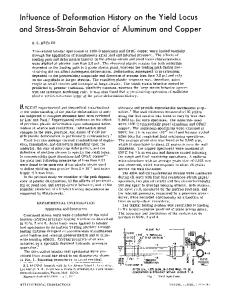Influence of Tool Offsetting on the Structure and Morphology of Dissimilar Aluminum to Copper Friction-Stir Welds
- PDF / 2,090,186 Bytes
- 10 Pages / 593.972 x 792 pts Page_size
- 88 Downloads / 319 Views
NING dissimilar materials with high chemical affinity and completely different physical and mechanical properties, such as aluminum and copper, has already been recognized as an additional challenge in friction-stir welding (FSW) development.[1] In fact, the establishment of dissimilar welding parameters, enabling adequate metal flow around the tool, and simultaneously, avoiding the formation of large amount of brittle intermetallic compounds, which seriously deteriorate the strength and surface morphology of the welds,[2] has not been achieved yet. The development of new welding strategies, such as using interlayer materials,[3] conceiving new joint design solutions,[4,5] or offsetting the tool from the dissimilar base materials interface, to avoid intensive mixing during welding, are currently pointed as solutions for achieving successful dissimilar joining. Among the alternative welding strategies mentioned in the previous paragraph, tool offsetting has been the most explored technique for aluminum to copper (Al/ Cu) friction-stir welding. Okamura and Aota,[6] who were among the first to report the use of this technique in Al/Cu welding, shifted the tool pin toward the IVAN GALVA˜O, Ph.D. Student, and ALTINO LOUREIRO and DULCE MARIA RODRIGUES, Professors, are with the Department of Mechanical Engineering, CEMUC, University of Coimbra, Rua Luı´ s Reis Santos, 3030-788 Coimbra, Portugal. Contact e-mail: [email protected] DAVID VERDERA and DANIEL GESTO, Engineers, are with the AIMEN, Relva 27A Torneiros, 36410 Porrin˜o, Spain. Manuscript submitted February 11, 2012. Article published online August 23, 2012 5096—VOLUME 43A, DECEMBER 2012
aluminum side in FSW of 8-mm-thick plates of 6061 aluminum alloy to oxygen-free copper. Restricting the pin stirring action to the aluminum side, they avoided base materials mixing and, consequently, inhibited the formation of brittle Al/Cu intermetallic phases during welding. The authors pointed out that the diffusion bonding, which took advantage of the friction plastic flow phenomenon taking place during welding, resulted in the production of less defective welds with improved surface appearance relative to welds obtained by traditional nonoffsetted FSW procedures. However, in spite of this, the offsetted welds displayed very poor tensile properties. Genevois et al.[7] also used tool offsetting in frictionstir welding of 4-mm-thick 1050-H16 aluminum alloy to commercially pure copper plates. These authors used full offsetting, with the pin fully displaced to the aluminum side, working tangent to the copper plate. No mechanical mixing between the base materials was observed in these conditions. The authors reported that frictional heating promoted thermally activated interdiffusion at the Al/Cu interface, giving rise to the formation of a very thin layer of intermetallic compounds (about 200 nm). No results concerning the structure, surface finishing, and mechanical properties of the welds were presented, which did not allow evaluating the effectiveness of this technique in obtaining sound bond
Data Loading...











